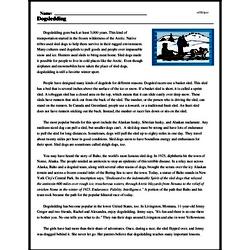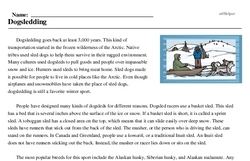Dogsledding
Dogsledding goes back at least 3,000 years. This kind of transportation started in the frozen wilderness of the Arctic. Native tribes used sled dogs to help them survive in their rugged environment. Many cultures used dogsleds to pull goods and people over impassable snow and ice. Hunters used sleds to bring meat home. Sled dogs made it possible for people to live in cold places like the Arctic. Even though airplanes and snowmobiles have taken the place of sled dogs, dogsledding is still a favorite winter sport.
People have designed many kinds of dogsleds for different reasons. Dogsled racers use a basket sled. This sled has a bed that is several inches above the surface of the ice or snow. If a basket sled is short, it is called a sprint sled. A toboggan sled has a closed area on the top, which means that it can slide easily over deep snow. These sleds have runners that stick out from the back of the sled. The musher, or the person who is driving the sled, can stand on the runners. In Canada and Greenland, people use a komatik, or a traditional Inuit sled. An Inuit sled does not have runners sticking out the back. Instead, the musher or racer lies down or sits on the sled.
The most popular breeds for this sport include the Alaskan husky, Siberian husky, and Alaskan malamute. Any medium-sized dog can pull a sled, but smaller dogs can't. A sled dog must be strong and have lots of endurance to pull the sled for long distances. Sometimes, dogs will pull the sled up to eighty miles in one day. They travel about twenty miles per hour in good conditions. Sled dogs seem to have boundless energy and enthusiasm for their sport. Sled dogs are sometimes called sleigh dogs, too.




